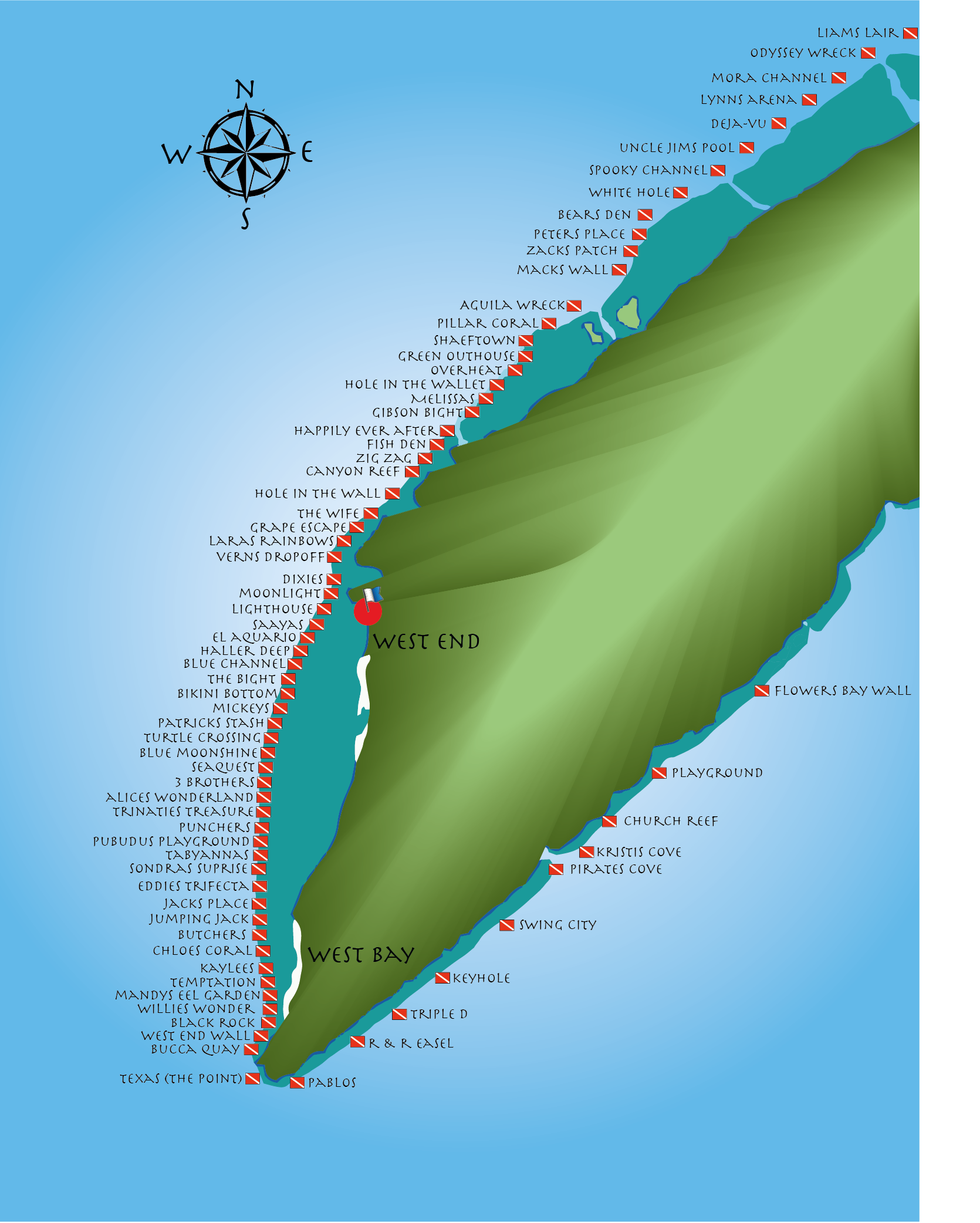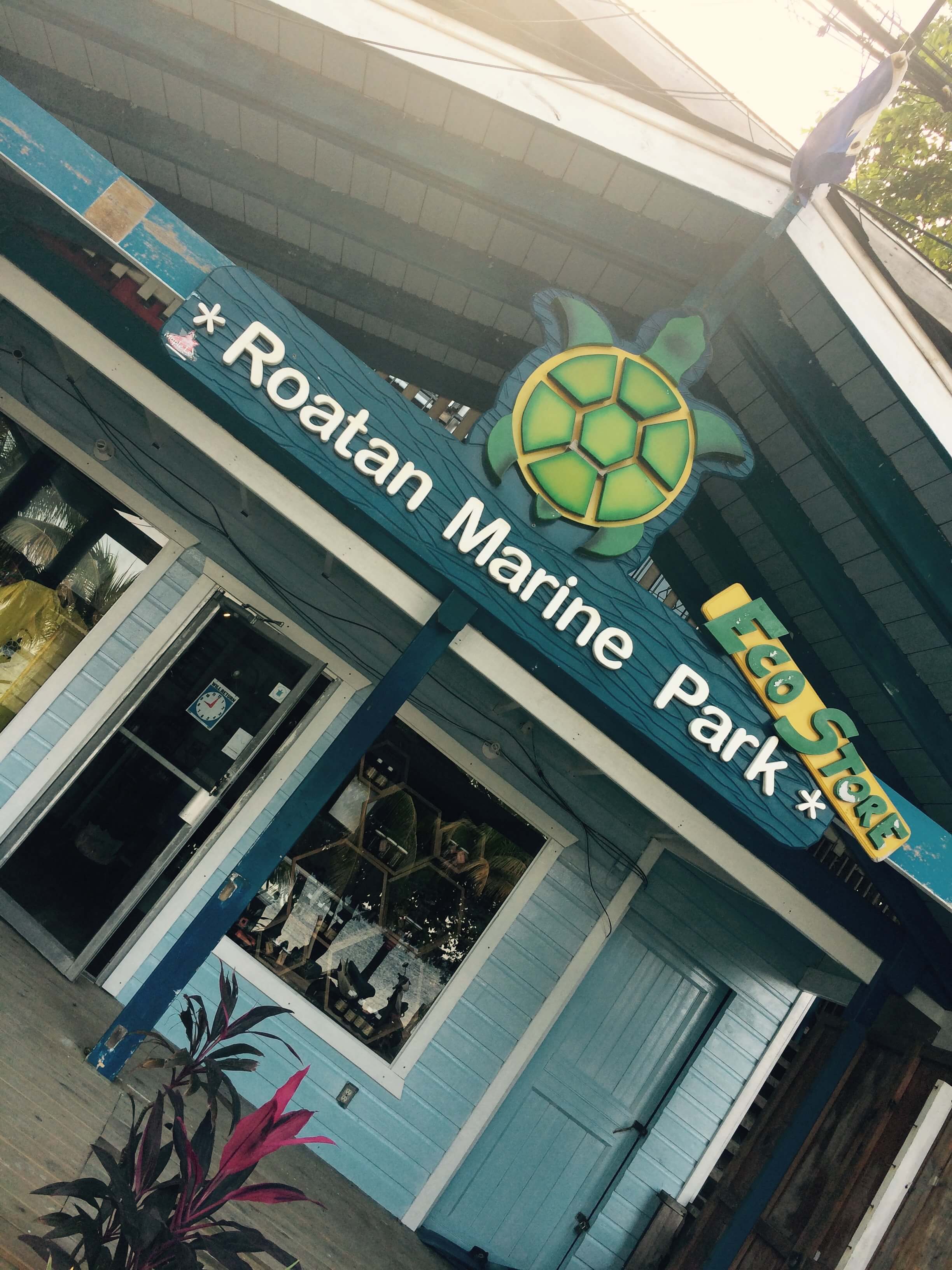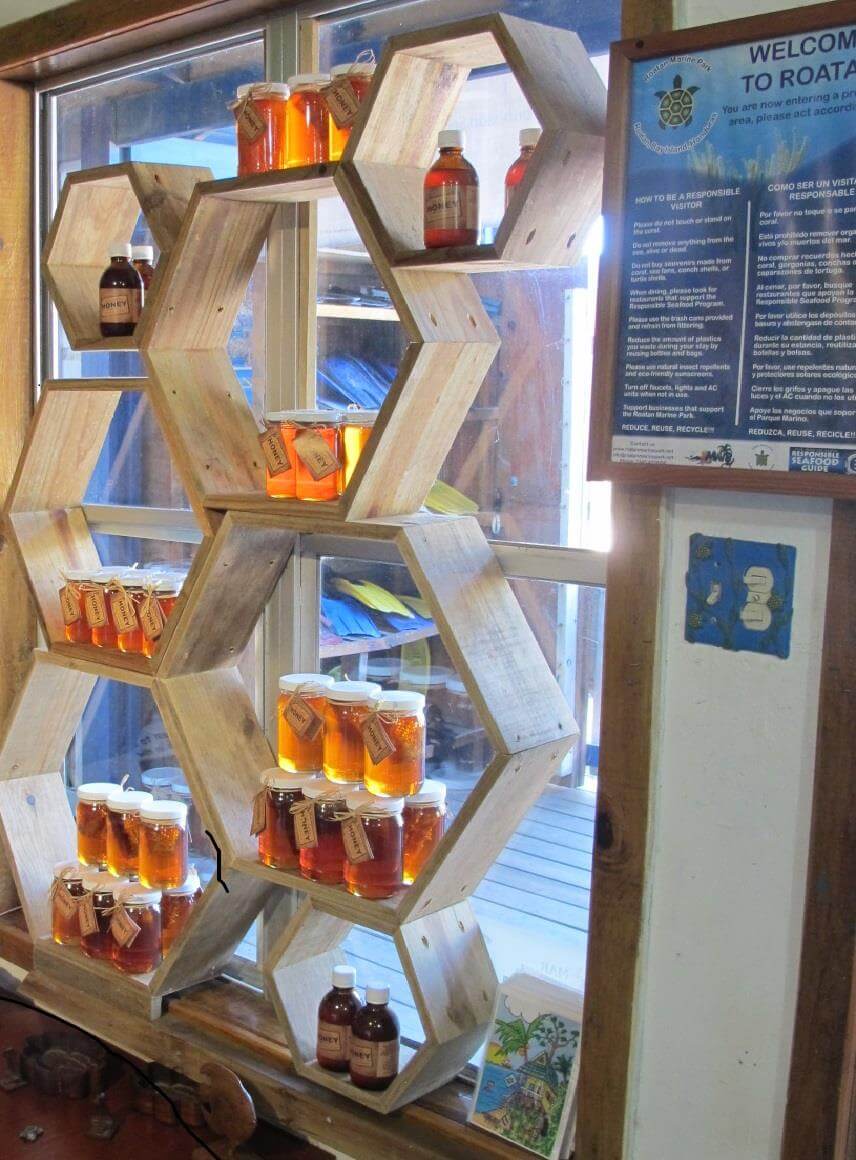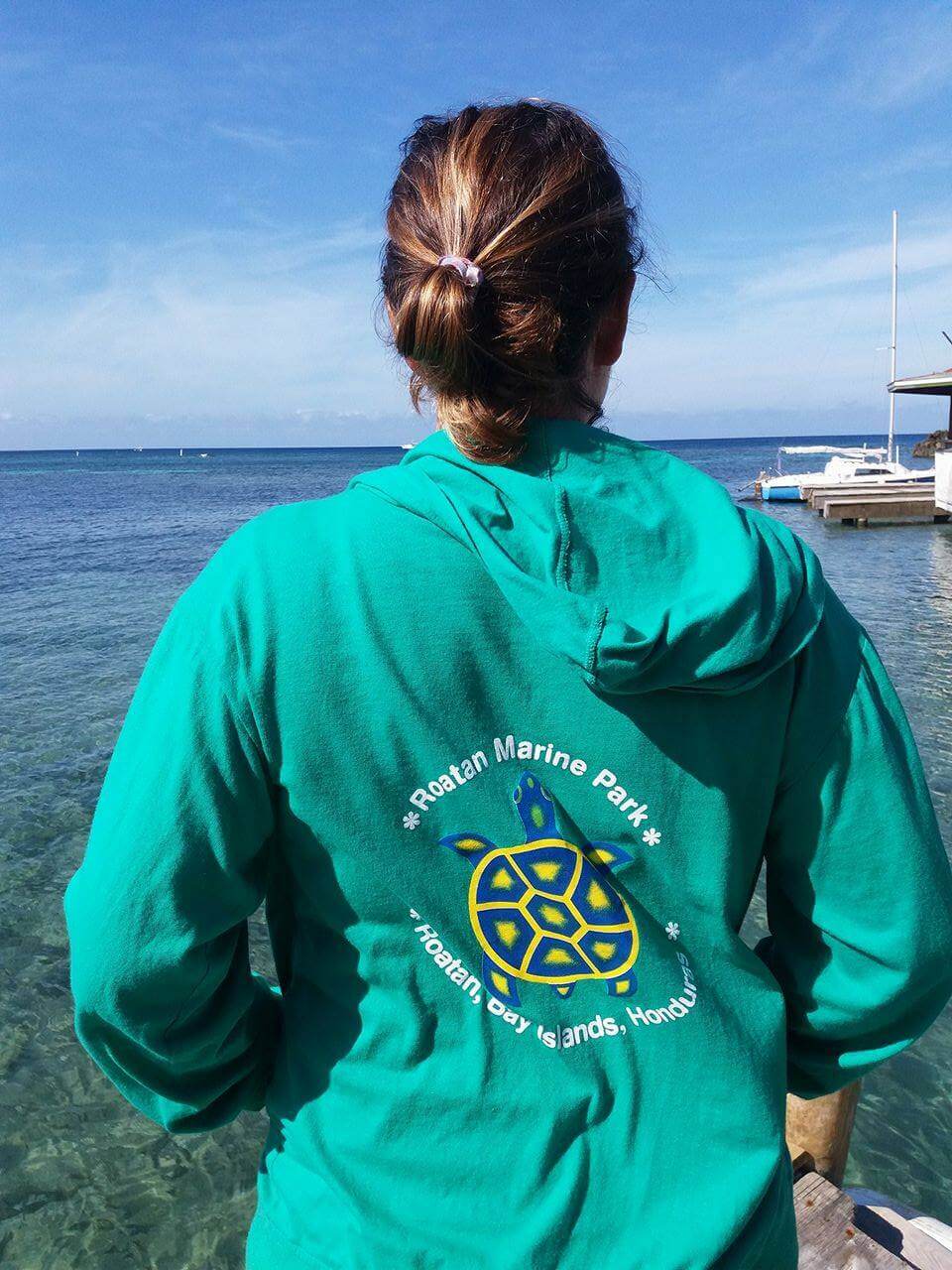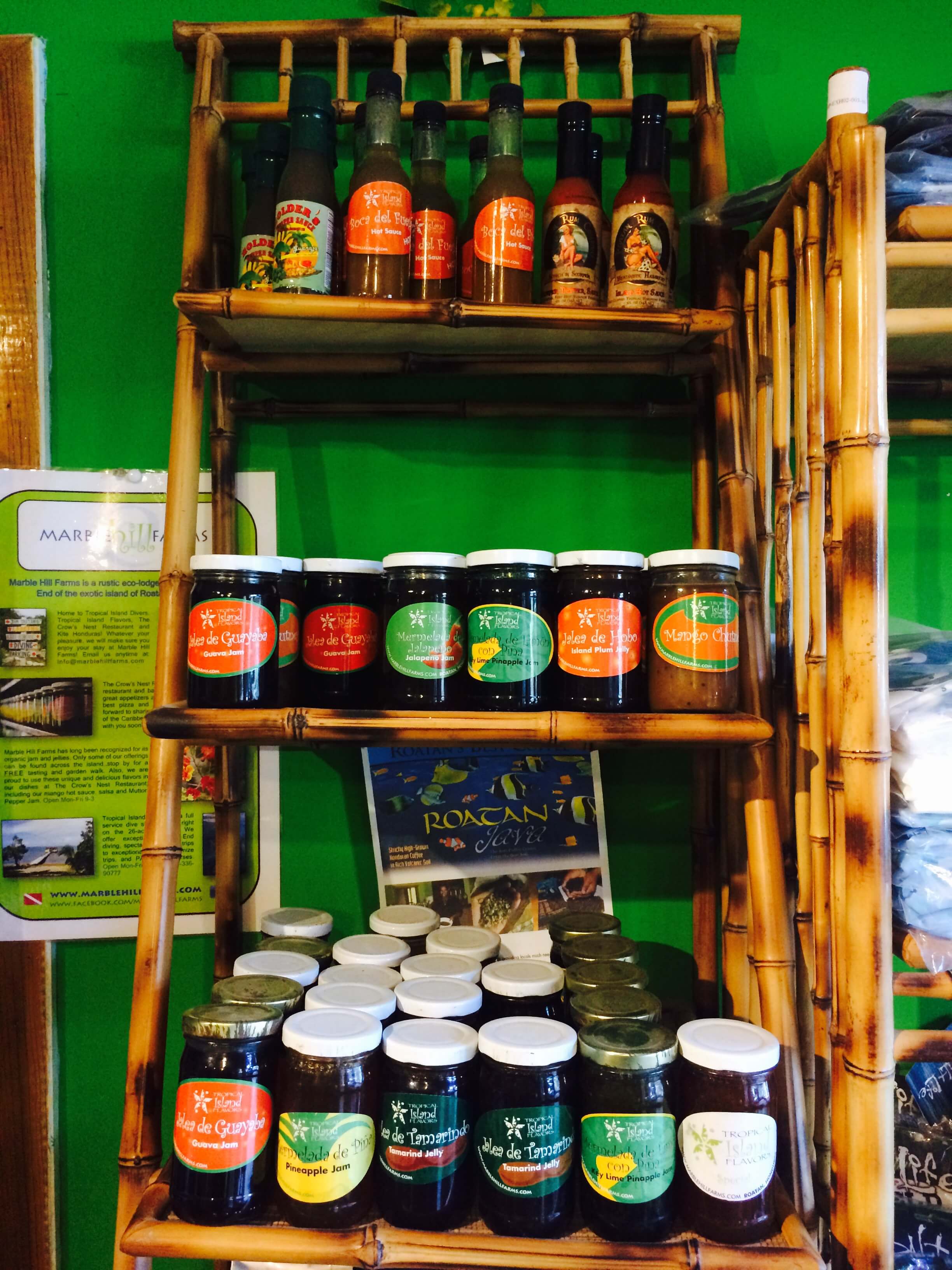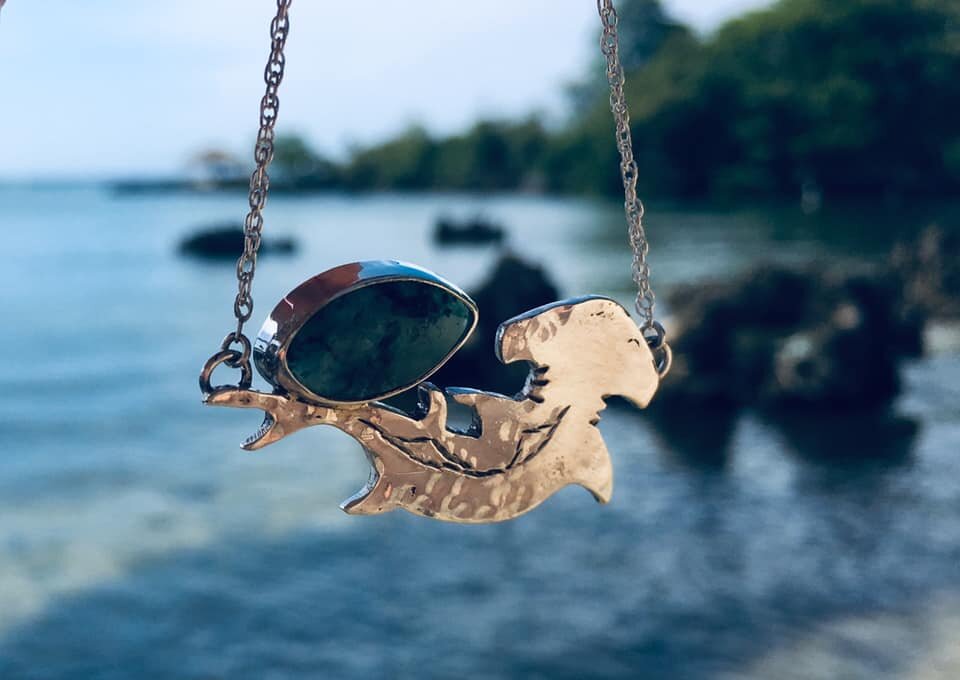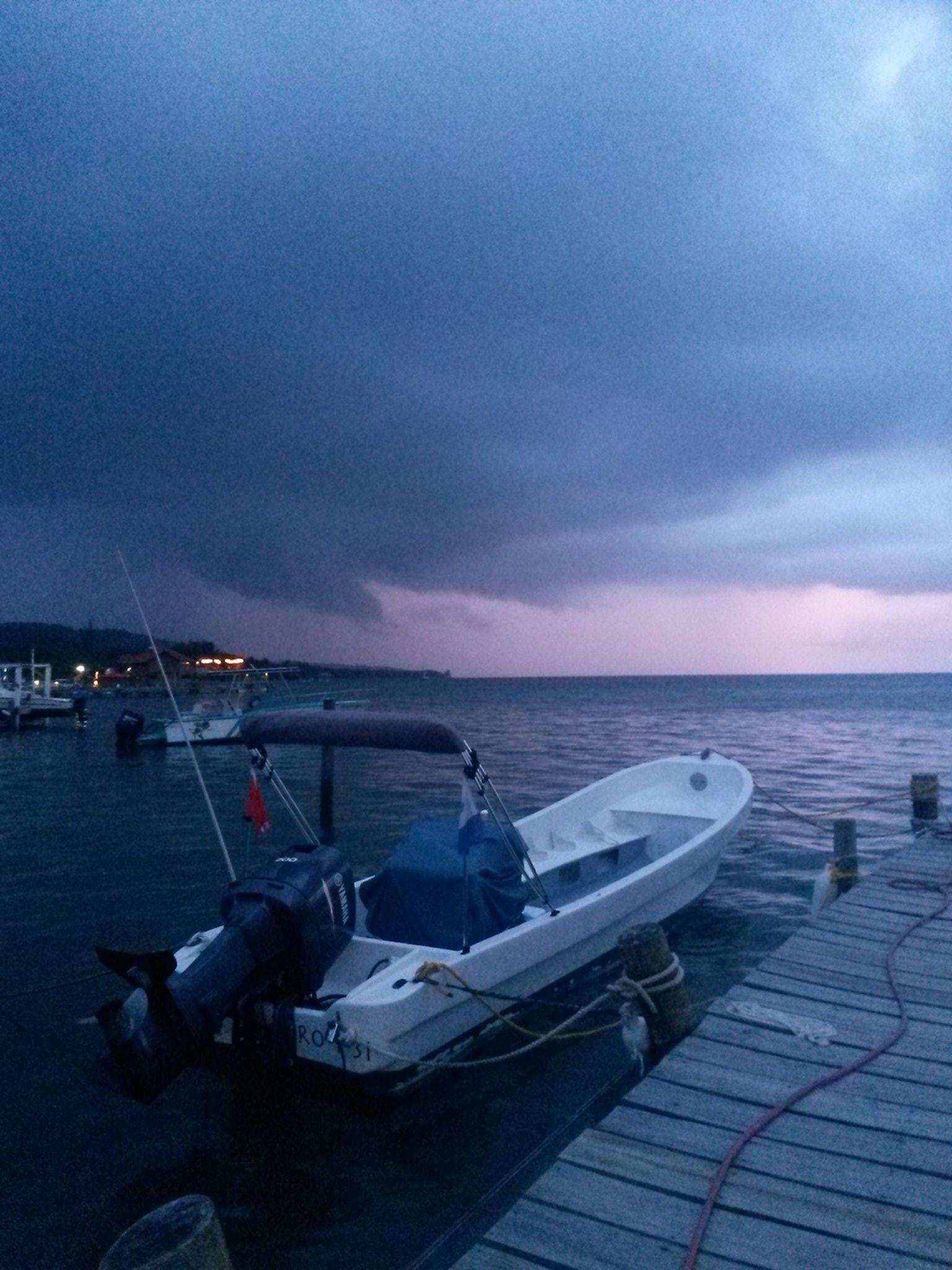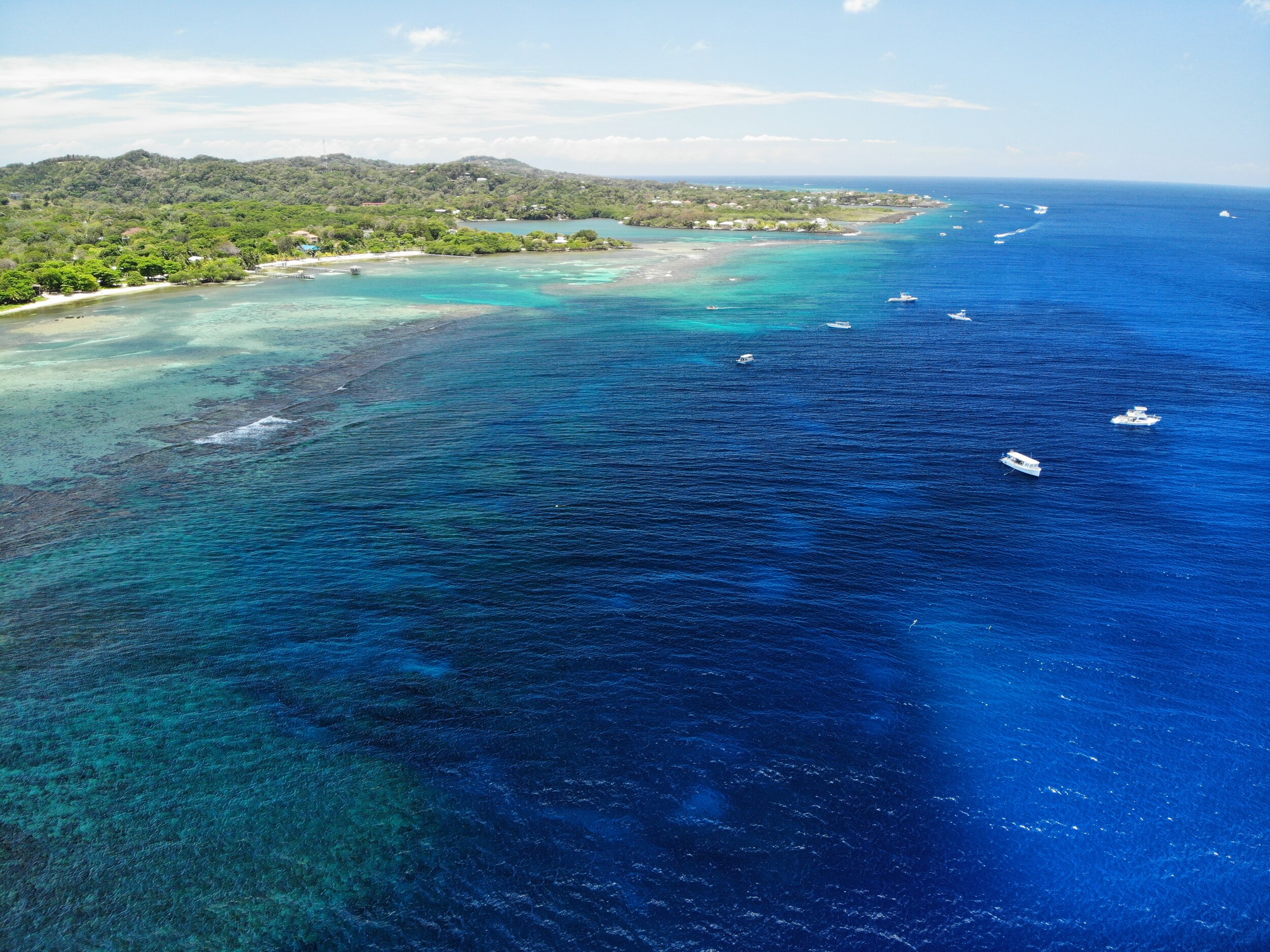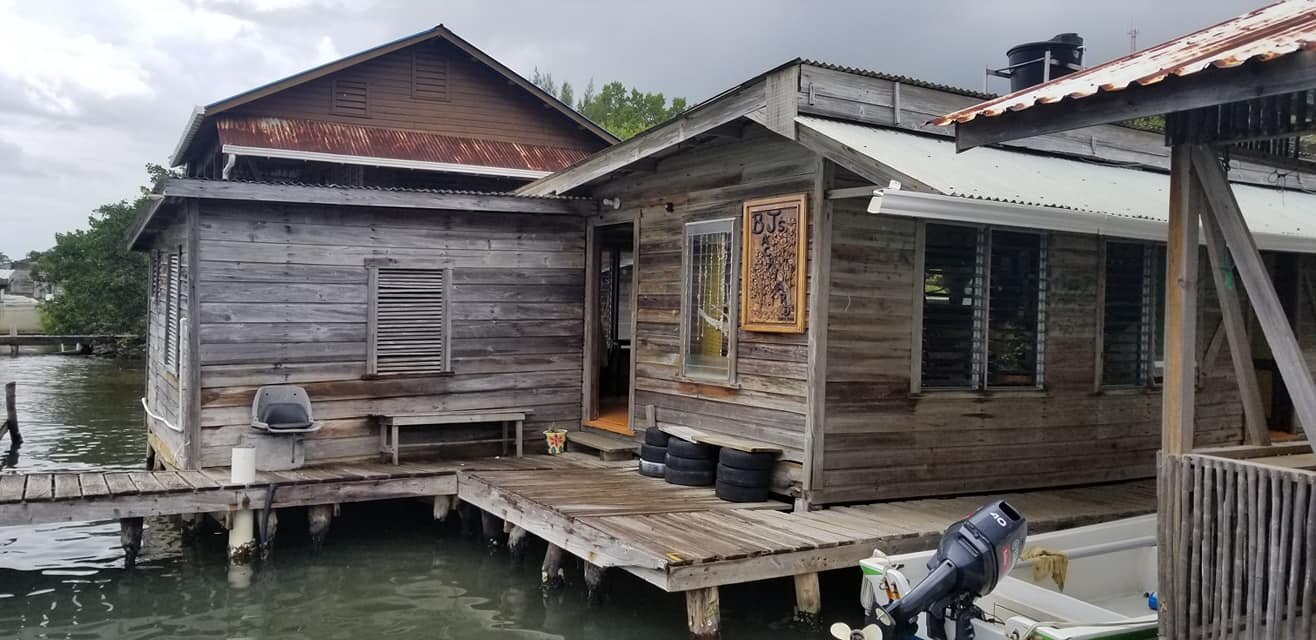How Much Does It Cost to Stay in West End, Roatan for a Week?
So you're coming to visit Roatan for a week or so, fantastic! When it comes to travel expenses like food, transport, lodging and activities, many travelers want to have an idea of how much to budget. One thing to note: costs here on Roatan might not be what you expect.
So you're coming to visit the West End area of Roatan for a week or so, fantastic! When it comes to travel expenses like food, transport, lodging and activities, many travelers want to have an idea of how much to budget. Spoiler Alert! Things here in West End might not be what you expect.
When you think of Roatan as being part of Honduras, many travelers expect things to be super affordable since we're in Central America. The reality is that Roatan is an island, and almost everything consumed here is imported. Our food, products and supplies had to undergo a much longer journey to make it to our happy island, and therefore that drives up the price of just about everything.
Let's do a quick breakdown on the most common travel expenses when visiting West End, Roatan. Keep in mind that when it comes to other islands and what things cost there, Roatan still ranks high in terms of affordability and getting the most bang for your buck.
Food & Drink Costs
The view from Ginger's Caribbean Grill, across the beach from Roatan Divers
Whether you are eating out at a restaurant or buying groceries, expect the price to be what you would typically pay in the United States. We have big supermarkets in Coxen Hole and French Harbor, which carry many of the common American name brands most tourists recognize. On average, these goods will cost the same, if not more than if you were buying them at your local grocery store.
For eating out at most restaurants in West End, expect to spend around $8-$13 per person (not including tip). Food can run about $15-20 a person at a few of the more upscale establishments. To read more about tipping policies and other FAQ here on the island, go here for a helpful guideline.
And sure, it's possible to find cheaper eats depending on what foods you enjoy (think fried food and lots of carbs)! Here in West End, we do have local street vendors, serving typical Honduran food, like Baleadas and platos tipicos (meat, beans and rice) for around $5.
We know, we know - the biggest question on your mind is how much a beer costs, right? Many of us like to gauge the affordability of a travel destination by their cost of beer. In Roatan, average cost for local beer is about $3, wine & imports (think U.S beers) $5, and cocktails between $5-7.
Lodging
West End sits at just about 1 mile long, and within that area is a range of accommodation options for travelers. Whether you prefer a more established hotel in the heart of West End or a home or condo for rent on the outskirts if you enjoy being off the beaten path a bit, there's always somewhere you can find that will fit your needs.
Hotels
Prices for hotels in West End can range from $35 to $200 a night (not including hostels), so every budget is covered. Important factors to consider when thinking about your hotel options are the time of year (high season prices vs low season prices) and if they include A/C or offer any meal options in their price. Hotels here are generally pretty small in size and they bring much of the charm and small community setting that people love about Roatan.
It's important to note that while West Bay has all-inclusives, hotels in West End do not. Most hotels don't include breakfast, either, so make sure to keep that in mind and read up on the fine print when you're searching for accommodation.
What are some nice hotel options? The Beach House Roatan is a luxury, boutique hotel located in the center of West End and sits directly on Half Moon Bay. Prices start at $175/night + 19% tax and include breakfast. For travelers wanting a more affordable, basic accommodation, we invite you take a look at Anderson Sunset Villas. They offer studio rooms and two-bedroom apartments between $45-75/night. Contact us for availability.
Vacation Rentals
Depending on the size of your group, a vacation rental condo or a house might be what you're looking for. With prices ranging from $600-1,200/week for 1, 2 or 3 bedroom options, condos can cut down on your accommodation expenses (one 2 bedroom condo can be cheaper than getting 2 hotels rooms) and give you the freedom of cooking your own meals. Caribbean Colors offer a variety of properties in West End and the surrounding areas, and their properties offer modern amenities, great locations and stellar service.
Transportation
If you're staying in the West End area, the great news is that you can walk to practically everything! Lodging, dive centers, restaurants and bars all sit within a small area. However, when it comes to airport transportation, traveling to Coxen Hole or the eastern areas of the island, you will need wheels. Taxis are a great, safe option to consider. They will be more expensive if you want a private taxi, but if you're fine sharing the ride with others, you can request a "collectivo". Taxis here don't have meters, so generally you will agree upon a price before getting in and heading out. The price will fluctuate depending on location and number of people. Remember to bring small bills, since taxies here rarely carry change!
Activities
Roatan offers a range of activities, but of course we are most famous for our diving! The costs for diving on Roatan is some of the most affordable in the world, especially when you consider how healthy and vibrant our reef is and how many dive sites we have to offer.
Other activities like ziplining, snorkeling, spas, fishing, golf, or boat excursions are available as well. The cost varies per operator, but we encourage people to consider responsible eco-tourism. For more information about supporting eco-conscious businesses, visit Go Blue Bay Islands, who together with National Geographic can guide you to vendors and operators who demonstrate their commitment to the environment. They rock!
Hopefully we've managed to give you a nice overview of what things cost here in West End and piqued your interest about staying on our beautiful island! For more information about currency on Roatan, check out our other post, 5 Things to Know About Currency on Roatan. As we mentioned, while Roatan may not be be the cheapest destination available, it's still a great value when you take into account the total cost of a trip here, combined with the amazing value of being a part of a small island community with a nice blend of modern and rustic vibes.
Want to know more? We're happy to help guide you through planning your next holiday to Roatan so please send us a note. We can't wait to hear from you!
5 Great Reasons to go Scuba Diving on Roatan
Roatan is often called the jewel of the Caribbean because of its many amazing features - its lush, hilly landscape, azure waters, the friendly people and diverse and rich culture. With direct international flights from Houston, Miami, Atlanta, Cayman and San Salvador, it’s also never been easier to get to paradise. Here are 5 great reasons we think you should go scuba diving on Roatan!
Roatan is often called the jewel of the Caribbean because of its many amazing features - its lush, hilly landscape, azure waters, the friendly people and diverse and rich culture. With direct international flights from Houston, Miami, Atlanta, Cayman and San Salvador, it’s also never been easier to get to paradise! Roatan’s claim to fame is, of course, its amazing reefs and marine life, so going scuba diving should be on the top of your "to do" list when you visit. Even if you've traveled to other popular dive destinations without going diving, here are 5 great reasons we think you should go scuba diving on Roatan!
Reason 1. The dive sites are super close
Since the reef starts only a few hundred feet from land, the entire island is basically one giant dive site. From West End alone, we have over 30 dive sites within a 10 minute boat ride, which means less time on the boat and more time in the water! Most dive centers run single tank trips because of the proximity of the dive sites to the dive centers, so you have the choice of one, two or three dives in the day and can spend your surface intervals comfortably on the beach with a cold lemonade (or beer, but only after diving!) in hand.
Reason 2. So nice, but you don't have to do them twice
The benefit of having so many dive sites in such close proximity means that unless you request to repeat a site, you don't have to. Obviously, if you're doing 50 dives out of West End, then yes, you will end up repeating some sites, but it's very easy to create variety in your diving experience. The West Bay area is filled with sand chutes, coral plateaus and mini-walls, while you get cool canyons and deep walls as you move towards Sandy Bay, so there are loads of cool topographies and points of interest to explore.
Reason 3. Diving a healthy reef in a protected marine park
The Roatan Marine Park was started as a grassroots movement 10 years ago to add additional protection to the marine reserve already set in place by the Honduran government. The last ten years have been a long battle for the Roatan Marine Park, but the fruits of their labor are definitely showing. In the Healthy Reefs 2015 Report Card for the Mesoamerican Reef, Roatan ranked highest in coral health and fish populations. Many other famous dive destinations, like the Great Barrier Reef, were not so lucky.
The continued work that the Roatan Marine Park does in conservation is what helps preserve our beautiful reef for many more years to come, so make sure to support them by purchasing a $3 daily ticket or $10 yearly bracelet.
Reason 4. Calm, clear conditions with mild currents
A pregnant grouper
Throughout most of the year, we enjoy relatively calm, flat water on the surface, with underwater visibility averaging around 100ft/30m. While currents can vary from day to day, we usually have mild currents that make scuba diving a much more relaxing and enjoyable experience.
When the weather does get rough on the north side of the island, many dive shops in Roatan have the flexibility to dive on the south side of the island, where you can once again find calm, flat conditions for diving. This type of flexibility is practically unheard of in most popular dive destinations. For us, we have a sister dive center that we partner with so that we can still offer our guests the same quality diving experience from both sides of the island.
Reason 5. Diverse marine life
While our colorful marine life population ties in strongly with Reason 3, we couldn't help but shine a special light on Roatan's underwater inhabitants. Whether you enjoy some of the bigger creatures or enjoy spotting the smaller, more hidden invertebrates we have it all! By having a healthy reef, it in turn brings in a variety of fish, crustaceans, bottom dwellers, shrimps and pelagic fish to these warm Caribbean waters.
So there you have it, 5 great reasons to go scuba diving on Roatan! If you're not a certified diver, there are plenty of ways you can still interact with our marine world, whether it be with snorkeling or with the PADI Discover Scuba Diving program. Our life on land ain't too shabby, either, so start planning your trip to Roatan today for the holiday of a lifetime!
4 Cool Souvenirs from Roatan
We'd like to share with you our top gift ideas that can allow you to take a piece of Roatan back home with you, all while shopping responsibly and supporting local artists and business.
The word 'souvenir' can make many of us cringe, thinking of kitschy items made of plastic that can be found at just about any travel destination. Just like every other tourist destination, we have a long list of shops and trinkets to choose from. Some items for purchase here, unbeknownst to you, may have been illegally poached and are in violation of local laws and regulation. How can you find a meaningful memento that does some good in the process?
We'd like to share with you our top gift ideas that lets you to take a piece of Roatan back home with you, all while shopping responsibly and supporting local artists and business. Without further adieu, and in NO particular order...
Rusty Fish- Recycled Island Art
"We have nothing from China!" is proudly declared at each of their several locations here in Roatan. We love that this local business has found a stylish and affordable way to take someone's trash and turn it into another person's treasure! They create handicrafts and artwork from recycled metal, wood, plastic and glass. From wall art to magnets to jewelry and much more, they have a great selection to choose from. Much of their artwork is inspired from our local marine life. It's a great way to take a memory of that beautiful green turtle you spotted in the ocean back home with you! With locations in West End, West Bay, and both cruise ship ports, this is an easy place to visit, even if you're only here for the day.
Roatan Marine Park- Eco Store
In addition to the amazing work they do keeping our reef healthy and beautiful, the Roatan Marine Park Eco Store offers a selection of merchandise and eco-friendly local products. The revenues from these sales go back to support the Marine Park and their local conservation efforts. They offer colorful t-shirts, tank tops, and even long sleeve hoodies that are just right for a breezy night here on the island. Also for sale is locally made honey, coffee, jams, jellies, eco-friendly mosquito repellents, and even hot sauce!
Amazing custom piece by Pink Ginger Jewelry
Local artists
A truly fun souvenir to take home with you is a locally handmade piece of art or jewelry. You can typically find local vendors either walking the streets or beaches offering up necklaces, earrings and bracelets for both men and women. Beautiful stones and intricate braiding make these jewelry pieces truly one of a kind.
If you enjoy artwork, you can find prints, paintings, and canvases full of bright and beautiful colors to remind you of the Caribbean.
Caribbean Reef Life
After just about every dive and snorkel trip, this is the book you see in people's hands as we look back at the colorful and lively marine life we see here in Roatan. This is a must-have for any fish enthusiast who enjoys marine identification photographs by local photographer, Mickey Charteris. The current edition includes over 1,000 species in full color and descriptions for each species. All the photos were shot here in the Bay Islands. Without knowing what creatures live underwater, it's hard to truly protect and care about the reef and its inhabitants. This makes a great coffee table book or keepsake to remember Roatan by!
Not in Roatan?
No worries! Most of our favorite gift ideas are available for purchase online. Visit their website or contact them directly to find out how you can have a piece of Roatan sent to you and your friends.
8 Easy Ways to Prepare for a Storm
Storm preparedness is imperative to surviving a storm (in style). After three years of storm power outages, we finally bit and bought a generator, which was immensely helpful. We will, however, be omitting ideas like that, as we're just focusing on affordable and easy ways to prepare for a storm. Let's have at it!
Well, Hurricane Earl came and went, and fortunately its trajectory changed at the last minute and Roatan was able to avoid a lot of the predicted damages. The island still suffered, but not to the extent that we all thought, and for that we are grateful. Other parts of Central American were not so lucky, and we wish them well in their continuing reconstruction efforts.
We have been through a variety of storms since we came to Roatan three years ago, but since Roatan is below the hurricane belt, this is the first time in several years where there has been even the possibility of a hurricane reaching Roatan's shores. We had seen this one coming for a week and the forecast had gotten worse in the three days before Earl's arrival, so we had ample time to prepare. And while the worst of the storm missed us and we didn't have to implement all the preparations we made, it was a good test run to see how we would face next rainy season and to see if any changes need to be made.
Storm preparedness is imperative to surviving a storm (in style). After three years of storm power outages, we finally bit and bought a generator, which was immensely helpful. We will, however, be omitting ideas like that, as we're just focusing on affordable and easy ways to prepare for a storm. Let's have at it!
Tip 1. Research and make a checklist
Before we started preparing, we made a checklist of what we needed to get through this storm based on what we felt we were missing in the last storms. We had a general idea of what we would need, but we wanted to make sure that there wasn't anything significant that we missed. We went online to look up different preparations lists, and figured out what we felt was useful and feasible.
When you make a checklist, make sure to also write down any emergency numbers you may need, and make a mental (or physical) plan for an emergencies that may crop up, like water leaks or power outages. It's better to be too prepared than to be caught unawares.
Tip 2. Stock up on non-perishables
It's important to hit the grocery store before a storm hits (but please don't hoard so that other people are out of food). While the storm itself may only last a day or two, there will always be longer lasting effects from the storm. Roads may get wiped out or power lines may go down, so make sure you are prepared with non-perishable items to get you through. Canned goods last forever (and can be used after a storm as well) and dry items like rice and pasta are good as well. If you have a gas stove, make sure that you have a lighter so that you can still cook while power is out. Try to focus on meals that can be made quickly in one pot or two, rather than things that require seven hours and eight courses.
Tip 3. Prepare food for the first day
Well, this seems contradictory after telling you to stock up on non-perishables, no? Try to prepare something, at least for the first day of the storm, so that you don't have to worry about cooking. We figured that power would go out, so I slow-cooked some food the night before, then transferred it to a Thermos cooker on the day of so that it would stay warm throughout the day. When the storm hit and power did go out, at least we had a warm meal to have. Food is a physical and mental experience, and getting to eat barbecue pork while the storm raged outside helped us feel more comfortable.
Tip 4. Store some water
When power goes, so does water, and it sucks to be out of power and not have enough water to be able to do normal things like flush the toilet. If you have a bathtub, it's a good idea to fill it up before a storm so that you can take the water as necessary. We don't have a bathtub, so we filled up three 5-gallon empty water jugs and kept them outside, filling up small containers and bringing the water inside when necessary. Even though water was out, we could still use the bathroom and rinse off dishes, which made riding out the storm much easier.
Make sure to also have some filtered water to drink. Even if you live somewhere where you can drink the tap water, storm surges can bring in all sorts of bacteria-laden water, and stagnant water can turn nasty as well. Keep several gallons of filtered water to be on the safe side. Getting stomach sickness with no power and no water is no fun, so it's better to be safe than sorry.
Tip 5. Let there be light
So you're all prepped with a homemade comfort meal and plenty of water to ride out the storm. And then the power goes out and you're sitting there in the dark. This is no bueno. Make sure you have plenty of light on hand for both safety and comfort.
A lot of people like to stock up on candles, which are the most affordable option, but candles tend to emit a lot of heat, which can make things stuffy when you're stuck in a room, can't open the windows because of the wind and rain and therefore have no air circulation. There are some nice solar powered options out there that charge quickly and are energy efficient, and the designs are getting sleeker every year.
Solar powered, inflatable and waterproof, good for all sorts of activities! https://mpowerd.com/
For an even more efficient light source, consider a headlamp. You have full use of your hands, whether you're cutting vegetables or trying to stop a leak, and headlamps are small and useful enough that you'll definitely find uses for them in daily life as well.
Tip 6. Buy phone data
When power goes down, wifi goes with it. Make sure you have enough data on your phone that you don't have to rely on external wifi. Social media is actually great for keeping people updated during emergencies, and is a good way for valuable information to be spread, especially if the information infrastructure isn't amazing where you are.
Tip 7. Top up your batteries
Before the storm hits, make sure all your electronic items are fully charged. This goes for phones, computers and even batteries for torches or radios. Using data on your phone can deplete the batteries quickly, so it wouldn't hurt to have some portable chargers as emergency backups as well. Portable battery chargers and solar powered battered chargers are super affordable these days with a lot space efficient designs, and it wouldn't hurt to have extra portable chargers for your every day life, either (I'm looking at you, Pokemon-Goers)!
Tip 8. Finish your household chores
I don't know if this is actually a thing, but it was for me so I'm going to include it. When we knew that a storm/hurricane would hit, I did all the laundry and all the dishes and made sure to clean the kitchen. Was it necessary? No. But I was also preparing for the possibility of no power and water for a few days, and nothing is more disheartening than having nothing to eat on or nothing to wear because it's all dirty. Making sure that everything was clean and usable before the storm hit was more for peace of mind, but I went into the storm feeling more prepared.
Bonus tip. Practice patience
Nothing tests your patience like no power and no water. Believe me, I know. But when the power is out all day, I try to keep my impatience in check and remember that as much as it sucks for me as a consumer, it really sucks for the guys working at the power plant and the linemen working on the power lines, trying to keep everything from falling apart. They have an enormously tough job, and a pretty thankless one considering we're all chomping at the bit to get them when our power becomes inconsistent. So when your area struggles to get back on its feet or isn't as efficient as it could be, practice patience and be kind.
So there you have it, some useful ways to prepare for a storm. Whatever storm comes your way, may you weather it well.
3 Cool Facts about the History of Roatan
Roatan is a cool island, there's no denying it. We have an amazing, well-protected reef, an interesting collection of cultures and a lush, hilly landscape that's unusual for the Caribbean. What else makes Roatan unique? Here are 3 cool historical facts that you may not have known about Roatan!
Fact 1. Columbus "discovered" the Bay Islands
Roatan, Utila and Guanaja were well-populated by the time Columbus came across them in 1502, but it was his "discovery" that first brought in Western influences to the islands. The Spanish and British started mining for silver and gold on the mainland, so the Bay Islands were raided for slaves to work the mines. The original inhabitants of the Bay Islands were probably the Paya people, and those that weren't taken as slaves succumbed to diseases born by the Spanish, like measles and smallpox.
Honduras itself means "depths", from the deep waters that plunge off its coasts. Christopher Columbus is said to have exclaimed, "Gracias a Dios que hemos salido de esas Honduras! (Thanks God we have departed these depths!)," when he entered the to-be-named Cabo Gracias a Dios in Trujillo, which provided calm shelter in the midst of a storm.
Fact 2. Roatan was a pirate hangout
Pirates were certainly not the first Western inhabitants of Roatan, but they were probably the most interesting. French and Dutch pirates used to lie in wait on the Bay Islands for passing Spanish galleon ships so they could take their treasure. Henry Morgan and Blackbeard were among the 5,000 pirates that called the Bay Islands home in the 17th century. Coxen Hole? Named after another famous pirate, John Coxen.
Fact 3. The Garifuna were "deported" to Roatan
The Garifuna are mixed descendants of Arawakan Indians, Island Carib and African people. The British colonialists also referred to them as "Black Caribs".
The Garifuna first started in the late 1700's, when about 2500 slaves were left on the island by the British (the journey started with 5000 people, but half of them didn't survive the journey). Those that didn't move to the mainland started a settlement called Punta Gorda, which is now the Garifuna cultural center of Roatan. As cultures go, they're relatively new, only going back around 200 years on this island, but their mix of British, Spanish and Black Carib culture makes them an interesting and integral part of Roatan and Central American history.
Did you already know these cool facts about Roatan, or did they surprise you? Let us know what other “3 Cool Facts” you’d be interested in learning, whether it be about scuba diving or Honduras, and let’s get our learning on!
5 Important Packing Tips for Roatan
Ever gotten back from a trip and felt like you’ve only used 10% of what you brought? Overpacking is easy to do, especially when you’re going to hot, tropical climates. Roatan has a very laidback vibe and casual clothing requirements, so to help you out before your trip we’ve put together our 5 most important packing trips for Roatan. Some of these tips will apply to packing in general and some apply to Roatan specifically, so check out our Top Five Tips and get packing!
Tip 1. Lay everything out
Before you start throwing things indiscriminately into your bag, lay everything out so you can see exactly what you're bringing. Making a checklist, preferably in writing, so you can note exactly what you will need for your trip. Packing 20 shirts, a pair of heels and just one pair of shorts may not be ideal for a 7 day trip to a beachy island, but you may not even know that you've packed all that if you're not keeping track.
Once you've laid everything out and made a plan, roll everything up and put it in your bag. Low on space? Head to Tip 2 for what to do next!
Tip 2. Need vs Want
There's a lot of stuff that we want to take on vacation, but how much of that do we really need? If you're visiting Roatan, you don't really need a pair of heels or hiking boots, just a pair of flip flops and maybe sneakers if you like to work out will do. Do you really need a fancy dress if you're staying in a hostel, or four pairs of long pants when the humidity is 90%? If you really want to bring those heels or those fancy dresses, go for it, but make sure that you've taken care of all your needs and that you have adequate space before you start packing your wants.
Tip 3. No shoes, still service!
On Roatan, shoes are a recommendation, not a requirement. Even at the fancier restaurants, like Roatan Oasis or Ibagari, you'll see at least one local sitting there barefoot. Now, your visiting city feet are probably not strong enough for you to wander around barefoot all the time here, but you also don't need to adhere to any strict dress codes here, either.
While this tip applies to everyone visiting Roatan for an extended period of time, it doesn't apply to people traveling on cruise ships. Most cruise ships have a fancy dress night, and we’re pretty sure you can't walk into the cruise ship restaurants without at least a pair of flip flops on, so make sure you pack at least one pair of nice shoes if you're cruise shipping.
Tip 4. Laundry is cheap on Roatan
If you're coming to Roatan for two weeks, you don't have to pack two weeks' worth of clothing. We have laundry shops all over the island, where you drop your clothes off and they'll have them washed, dried and folded by the next day. And we promise, no one around here will notice that you've worn the same shirt twice in *gasp* the same week, so save yourself the heavy lifting and pack light.
As a word of warning, your laundry is charged per pound. It normally runs about 45 lempiras, or $2.00-2.50 per pound, so make sure that you don't bring in sopping wet clothing or else the bill will be way higher. Also, dry cleaning is not an option here, so don't bother bringing down fancy silks. Cotton is the fabric of our lives.
Tip 5. Leave room for souvenirs
Anywhere you go, you're going to want to bring home souvenirs, either as a memento for yourself or as presents for family and friends.
To get some special, not run of the mill souvenirs, you can check out Rusty Fish, where they train locals to take locally sourced materials from the dump, like Texaco oil drums, and turn them into cool wall ornaments and magnets. The Roatan Marine Park stores sell Roatan Marine Park branded t-shirts and sweatshirts and locally made honey, jewelry, vinegars and jams, all benefiting the marine park and local communities. Rusty Fish and the Roatan Marine Park have stores in West End and both cruise ships ports, so whether you're visiting for a day or a week, you'll find an awesome memento of Roatan without being kitschy.
And if you want your friends to really love you, pick up some good ol' Caribbean rum!
So there you have it, our Top Five Tips for packing for Roatan! Happy packing and we'll see you all soon!







